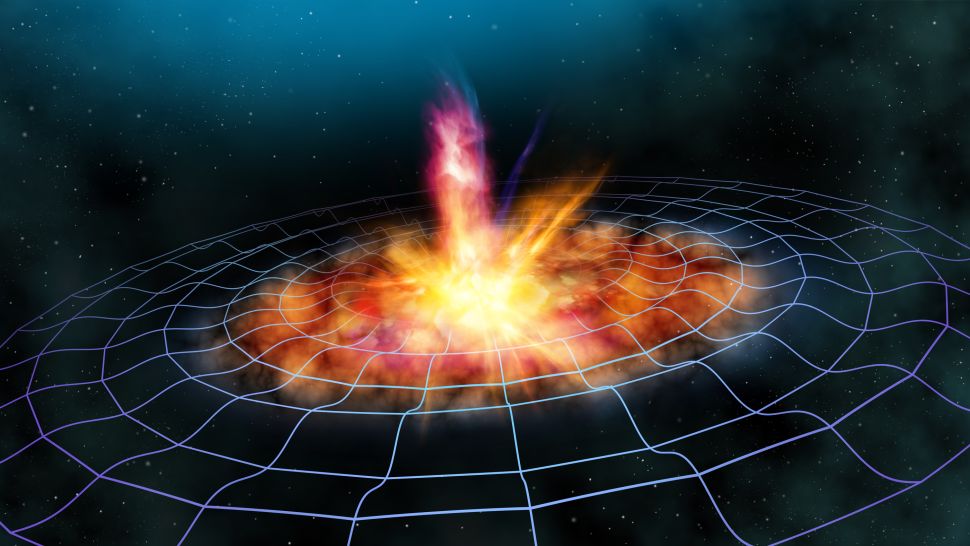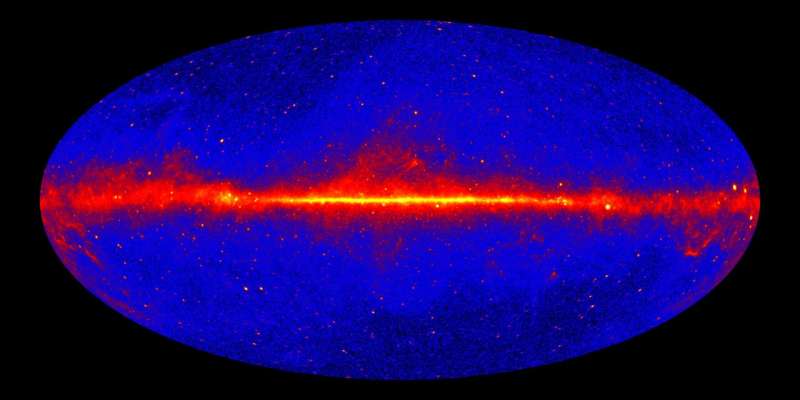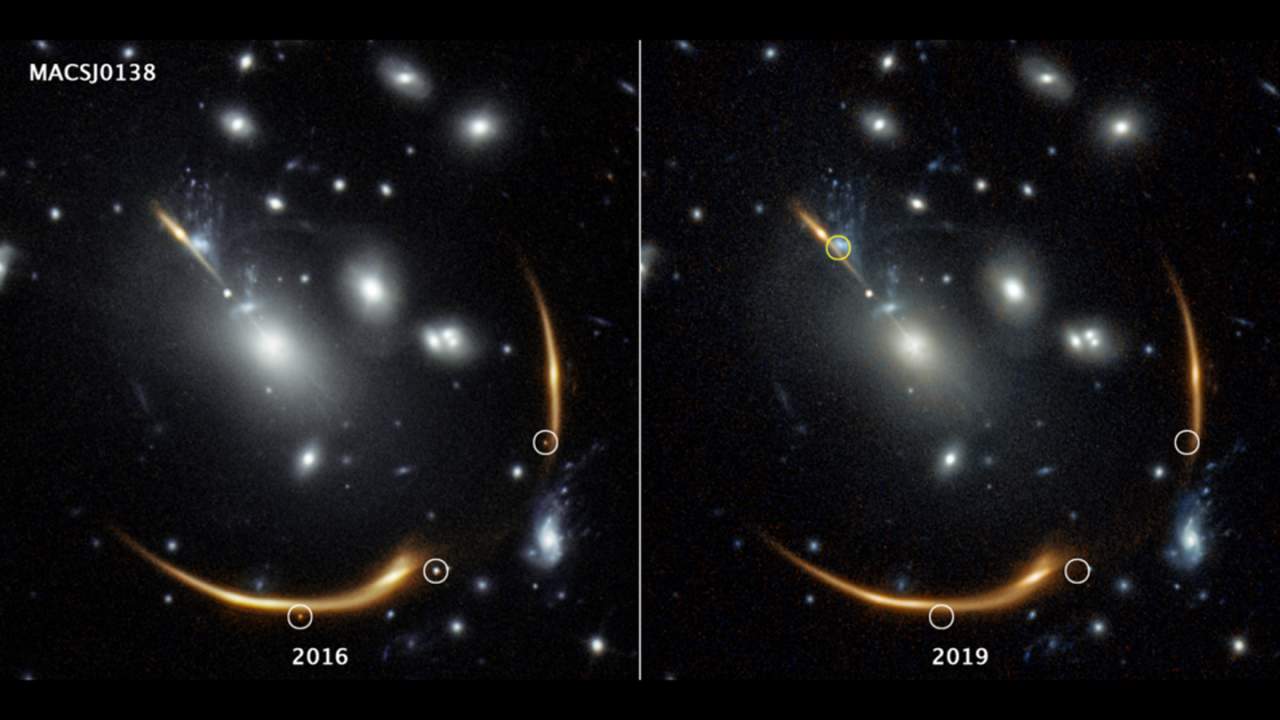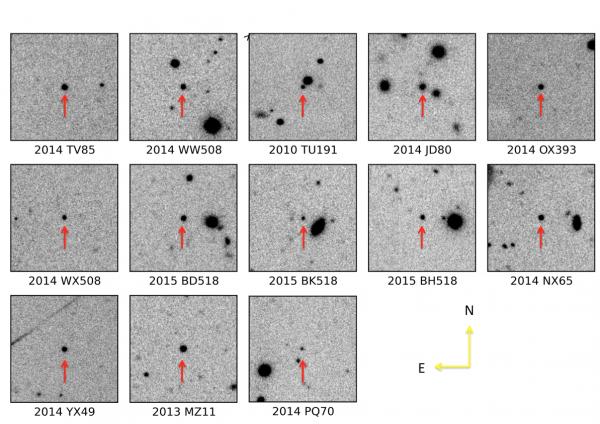A supernova first observed in 2016 will be replayed in a few years because of the light’s journey through a galaxy cluster and how dark matter gravitationally warps space-time. Plus, inactive centaurs, a Scottish ice wall, and a review of “Countdown: Inspiration4 Mission to Space”.
Podcast
Transcript
Hello and welcome to the Daily Space. I am your host Dr. Pamela Gay.
And I am your host Beth Johnson.
And we are here to put science in your brain.

One of my favorite phrases from Calvin and Hobbes is the line “scientific progress goes ‘BOINK’.” Today, we have documentation of this actually occurring, although “BOINK” is not the exact word used in the paper, which appears in Physical Review Letters and led by Maxim Goryachev. This team went looking for high-frequency, short-wavelength vibrations in space and possibly time that could be gravitational waves unlike any we’ve ever detected. The search was performed using an itty bitty sensor that was cooled to stop vibrations, and it was encased in materials that should have isolated it from all electromagnetic interference.
During two separate observing periods, researchers monitored a pair of related frequencies, and on May 12 and November 27, 2019, the detected science went boink. These were days during which nothing actually exciting occurred in the environment of the detector that might explain the detections.
In the paper, they discuss how what they measured could be something as mundane as a high-speed charged particle – something called a cosmic ray – hitting the detector. As an astronomer who has had my images interrupted but cosmic rays, I feel like this explanation is the Occam’s Razor of answers – it works, and it is consistent with reality. That said, what they saw could also have observed unknown thermal effects or even high-frequency gravitational waves from theoretical axions spinning around a black hole. Or something even weirder.
I am very much an “if you see hoofprints look for the horse” kind of person, but as a bunch of folks in Maryland recently experienced, sometimes, hoofprints actually belong to an escaped herd of zebra that are now wandering the suburbs.
I hope this team has funding to continue this work and can eventually explain exactly what is making things go BOINK in the detector.
It is not unusual in astronomy to detect things and at the moment have absolutely no idea what was detected. For instance, folks who study the highest energy colors of light – gamma rays – have found lots of brief bursts that we now know are related to neutron stars and supernovae. They have also found lots of regularly bright places, like feeding black holes. They’ve even found gamma-ray light coming from star-forming regions.

What has been a bit frustrating is the faint gamma-ray light that just kind of shines everywhere. Called “empty sky gamma-ray emission”, this is diffuse light that is seen in the otherwise dark areas of the sky. Since the source of the light hasn’t been directly detectable, a team of researchers turned to computer models to see what they could find.
In a new paper appearing in Nature and led by Matt Roth, researchers describe how a distant background of star-forming galaxies can produce enough gamma rays to explain what is seen while remaining too faint in other wavelengths. This is one of those nice results where everything fits together, nothing new is required, and while we can’t definitively say the paper is right, since we can’t see those galaxies, I’m completely good with this result.
At the time that we’re recording this, the Inspiration4 team is within 24 hours of their return to Earth. We hope and pray that all went well, and we will cover their mission in its entirety in our next episode.

While we don’t know their full story yet, we can tell you that three Chinese astronauts have returned to Earth after a 90-day visit to their space station, the Tianhe. This was the first of a series of missions planned for this year and next that will work to test systems and complete construction on this new station. During this first segment, they checked the basics like life support and tested a robotic arm – one not made by Canada – that will be essential in the future. Space belongs to no one, and we hope that by having multiple stations, the researchers of more nations will be able to conduct research in space.
Sometimes science is in slow mode.
Back in 2016, researchers observing the cluster MACS J1039 noted that its gravity was magnifying and twisting the light of much more distant systems, and, in those arcs, the shine of a supernova could just be seen.
This effect is called a gravitational lens. Light is affected by gravity just like everything else, and high mass objects – like MACS J1039 – can bend the path of light that was planning to go to one part of the universe so that it instead reaches us. This can actually focus a lot of extra light our way and make objects that are otherwise invisible bright enough to be seen.

The path this bent light takes is longer than it would be if the light was traveling straight toward us. Just how much longer is a matter of geometry. Imagine placing mirrors in different places that all allow you to see what is behind a blind corner. All those mirrors may be showing you the same thing, but because they are in different places, the light has to travel different distances to reach you.
On the scales of parking garages and roadways, these differences don’t really matter, but because light takes time to travel, on galaxy cluster scales, these differences can cause different versions of the same distant object to appear at different times. If the difference in geometry causes the light to travel a few extra days, we’ll see events like a supernova on repeat with the timing of two versions appearing the extra few days apart when they are brightest. With massive clusters, however, the difference can be years.
In MACS J1039, the three images of the background galaxy that showed us a supernova in 2016 are all separated by no more than weeks in the distance their light has to travel, and researchers saw the supernova at a variety of stages of brightening and fading. There are two other versions of that galaxy gravitationally lensed into visibility in this field, however, and they both require light to travel a much longer path to reach us. According to new calculations published in Nature Astronomy by Steven Rodney and his collaborators, those two additional versions of the background galaxy around 2037 and 2042, give or take a couple of years.
The “give or take a couple of years” comes from our lack of understanding of dark matter and how it does and does not cluster in galaxy clusters. Dark matter is a somewhat infuriating form of matter that interacts with gravity – because everything interacts with gravity – but doesn’t interact at all with light except through that gravity. Dark matter doesn’t give light off, it doesn’t reflect it; it just bends light via the gravitational pull of its own mass.
The research team behind this new work has run a variety of models to estimate how dark matter is clustered around the luminous stuff we see in this galaxy cluster, and based on those models, they have calculated how long it will take light to get sharply bent through the denser regions. The path the light takes isn’t a straight line, and in fact, it may be more of a ping-pong-ball path than even a simple curve. We don’t know, yet.
When the light from the supernova does finish its crazy detour through galaxy cluster MACS J1039, we will finally have a chance to sort which models are closest to reality when the light from that supernova once again makes it to our telescopes.
The scientists involved do express concern that while the 2037-ish arrival of supernova light should be visible, the 2042 arrival may be too faint because not enough light will be bent our way. I’m hoping that by 2042 things will be advanced enough that we’ll get all the data we need to put some serious constraints on our understanding of dark matter.
Unrelated to the geometry of space and time, this story also reminds us that the universe is big and that it is old. The supernova light that we’re seeing on repeat was initially fired into space ten billion years ago, and it originates from a star that was formed, lived, and exploded within the first four billion years of our universe. We are seeing into our universe’s distant past, and it’s helping us understand something fundamental about our universe.
Back here in our solar system, researchers here at the Planetary Science Institute have had a bit of a breakthrough when it comes to understanding one of the more mythical beasts we’ve discovered – centaurs.

Centaurs are a strange combination of asteroid and comet, big lumps of rock and ice out between the orbits of Jupiter and Neptune that occasionally put on a show by growing comas. They’re a curious creature, and to that end, a team of researchers got time on the Gemini North telescope in Hawaii to look at a selection of centaurs found in PANSTARRS-1 survey data.
Here’s the funny bit – they weren’t looking for inactive centaurs; they were looking for those comet-like tails. And found exactly none of the 13 bodies they were able to observe. But sometimes, not finding what you are looking for can give you insight into the inner workings of a system. In this case, by finding all these inactive centaurs, the team found a potential reason for just how the active ones begin giving off gas and dust.
Some of our audience may be following how we’re voting in this year’s Mineral Cup. Now, I know this seems like a non-sequitur but bear with me here. Water ice is one of the competitors, and while it won the whole competition a couple of tournaments ago, its inclusion is not without controversy. But Beth will happily point out that water ice meets the standard definition of a mineral — it’s naturally occurring and solid, and it has a specific chemical composition and a defined crystalline structure.
Except when it doesn’t. It turns out that there is such a thing as amorphous water ice, where the structure isn’t quite crystalline and can trap a ton of gas in between water molecules. And centaurs may have ice mostly in that form, but as their orbits are shifted closer and closer due to gravitational interactions with the ice and gas giants of our solar system, at a certain point, that amorphous ice suddenly gains its defined crystalline structure, releasing all the trapped gas.
Lead author Dr. Eva Lilly explains: The escaping gas from the amorphous water ice builds up pressure, which can, in turn, open sinkholes or cause landslides exposing other ices that will sublimate and create visible coma. This pressure can be so great it could eject boulders or chunks of the Centaur, similarly to what was observed during the outburst of Centaur Echeclus in 2005.
This change in state isn’t predictable, though, which is what really makes centaurs different from comets. We don’t know when or how their orbits will shift to cause that water ice to completely crystallize. These bodies came from the Kuiper Belt and Oort Cloud, to begin with, and their interactions with our larger planets are not easily calculated. Plus, centaurs, like comets and asteroids, are small and difficult to find. That’s not going to stop scientists from looking and working to gain a further understanding of these mythical creatures.
Speaking of ice, we have one more fun story to share with you. Game of Thrones fans will be familiar with The Wall, that country-wide barrier made of ice that blocked the North from the wildlings and the white walkers. In the tv show, it was an impressive bit of CGI that is supposed to be about 700 feet tall. Now, new research into the ice sheet that covered Scotland during the last ice age is doing that whole life imitates art thing.
While there wasn’t a Castle Black at the base of this ice sheet, a new video shows just what the Scottish town of Dundee would look like at the base of a kilometer-thick wall of ice. And it’s impressive. The video was created by Kieran Duncan, a lecturer in communication design at the University of Dundee in Scotland, with Max Van Wyk de Vries, a glaciologist at the University of Minnesota. They used data from scientific papers, ice models, and satellite images of Greenland’s ice sheets to create the short film. We’ll have a link to the full version in our show notes at DailySpace.org. Enjoy!
Review
by Ally Pelphrey

For today’s review segment, we watched the first episode of Countdown: Inspiration4 Mission to Space. “Countdown” is a beautifully produced Netflix docuseries following the all-civilian crew of SpaceX’s Inspiration4 as they prepare for spaceflight. It opens with a brief montage of space history and how outer space has captivated humanity since people first looked up at the sky; then it quickly segues into what it calls “Space Race 2.0”, the current space race between Elon Musk’s SpaceX and Jeff Bezo’s Blue Origin that we’re seeing unfold in the news every day, a lot of which we’ve covered here on the Daily Space. “Countdown” is exciting — there’s rock music! Fast planes! Rockets going brrrrr — and like the mission, inspirational. The documentary excels at sharing the wonder and excitement of space travel, making viewers want to root for everyone involved in this new space race.
The first half of the episode focuses primarily on mission commander Jared Isaacman, a thrill-seeking millionaire pilot. Background on his life and journey to becoming a civilian astronaut are interspersed with technical information about the Falcon 9 rocket and orbital mechanics as well as brief interviews with Isaacman’s wife, colleagues, and even Elon Musk.
At one point the interviewer asks Elon Musk what he thinks about the criticism of “the so-called billionaire space race”, people saying we should spend more time fixing problems here on Earth before we go to space. He acknowledges that we should pay attention to issues here on Earth, but that he still believes in the importance and wonder of space exploration.
This allows for a neat transition to Isaacman talking about Inspiration4’s goal of raising 200 million dollars for St. Jude’s Children’s Research Hospital. Issacman says with sincerity that he believes in the importance of leveraging his wealth and the publicity around Inspiration4 to help people. He says: …if we are going to live in a world where everybody is capable of going out and journeying amongst the stars, then we better fight childhood cancer along the way….the other thing is…the rest of the crew members have to represent the good we’re trying to do with the mission. We’re not going to go up with a bunch of fishing buddies…every person who’s going to join this mission has to be able to deliver a very powerful and inspiring story in their own right.
This is the foundation of what Isaacman calls their “mission pillars”, which drove crew selection. They wanted a crewmember to represent hope, a crewmember to represent generosity, and a crewmember to represent prosperity with Isaacman himself representing leadership.
The documentary then introduces the mission’s pillar of hope: Haley Arceneaux, a pediatric cancer survivor and St. Jude’s healthcare professional. We meet her mother, learn about her childhood cancer journey, and how she ended up on the Inspiration4 crew. It’s nearly impossible to not feel moved by Haley’s story; you can’t help but be excited for her, because, let’s be honest, despite all the problems associated with space travel, it’s still really, really awesome.
“Countdown” at its heart is about humans, not spaceflight technology. It hits every note we want it to hit about exploration, adventure, and triumph over adversity. All the things about space travel that move us. Just the one episode I watched for this review made me feel the same excitement I felt as a little kid at Space Camp.
But…
All the talk about turning humanity into a multi-planetary species and the undeniable fact that this new space race is funded by billionaires make me feel like I’m watching The Expanse — TV show or books, take your pick — unfold in real-time, and I’m not sure that’s something to be excited about. Still, I want so badly for the good things, the inspirational things about this story to be true.
Countdown: Inspiration4 Mission to Space is a limited series streaming on Netflix. Four episodes are currently available, with a fifth episode available on September 30.
This has been the Daily Space.
You can find more information on all our stories, including images, at DailySpace.org. As always, we’re here thanks to the donations of people like you. If you like our content, please consider joining our Patreon at Patreon.com/CosmoQuestX.
Learn More
Something Went BOINK in the Detector
- New gravitational wave detector picks up possible signal from the beginning of time (Live Science)
- “Rare Events Detected with a Bulk Acoustic Wave High Frequency Gravitational Wave Antenna,” Maxim Goryachev et al., 2021 August 12, Physical Review Letters
“Empty Sky” Gamma-Ray Sources Confirmed
- ANU press release
- “The diffuse γ-ray background is dominated by star-forming galaxies,” Matt A. Roth, Mark R. Krumholz, Roland M. Crocker and Silvia Celli, 2021 September 15, Nature
Astronauts Return to Earth From Chinese Space Station
Dark Matter Delays Supernova Signal
- A 10 billion-year-old supernova will soon replay before our eyes, new dark matter study predicts (Live Science)
- “A gravitationally lensed supernova with an observable two-decade time delay,” Steven A. Rodney et al., 2021 September 13, Nature Astronomy
Centaurs Are Not Like Comets After All
- PSI press release
- “No Activity among 13 Centaurs Discovered in the Pan-STARRS1 Detection Database,” Eva Lilly et al., 2021 August 10, Planetary Science Journal
New Video Models Scottish Ice Sheet Near Dundee
- University of Dundee press release
- Giant ice sheet towers over Scottish city like the Wall in ‘Game of Thrones’ in stunning video reconstruction (Live Science)
- VIDEO: Dundee under ice: a view of Tayside during the ice age
REVIEW: Countdown: Inspiration4 Mission to Space
- Netflix page
Credits
Written by Pamela Gay, Beth Johnson, Ally Pelphrey, and Erik Madaus
Hosted by Pamela Gay
Audio and Video Editing by Ally Pelphrey
Content Editing by Beth Johnson
Intro and Outro music by Kevin MacLeod, https://incompetech.com/music/


 We record most shows live, on Twitch. Follow us today to get alerts when we go live.
We record most shows live, on Twitch. Follow us today to get alerts when we go live.